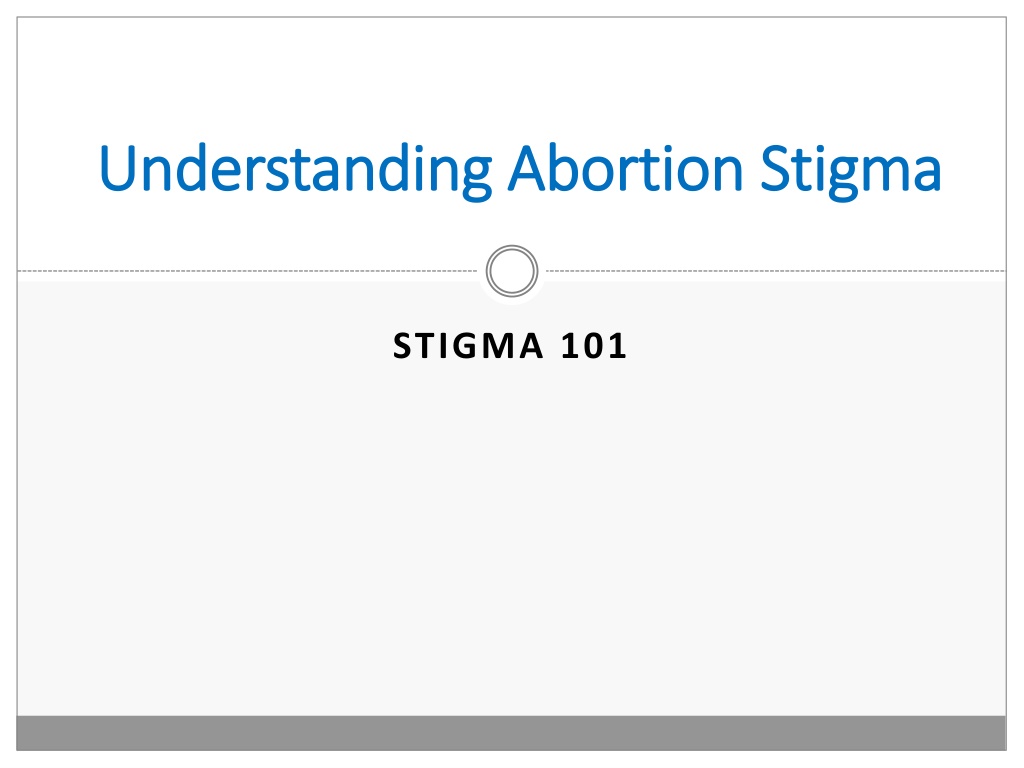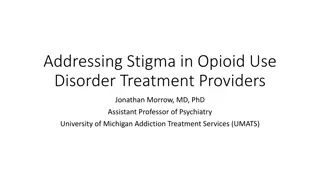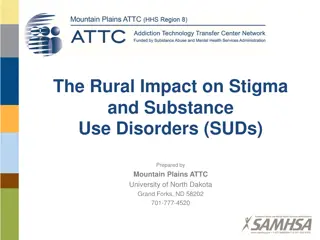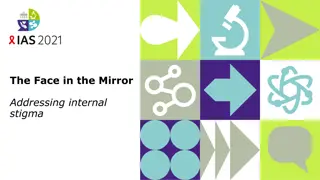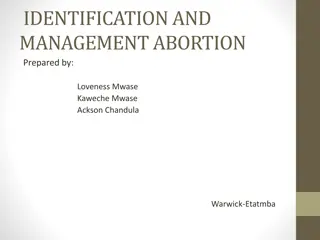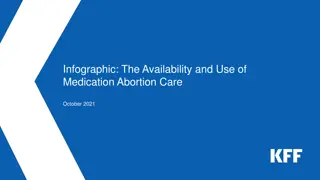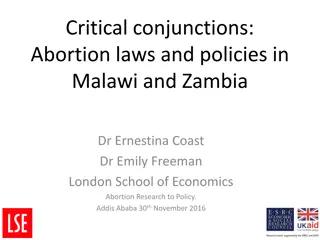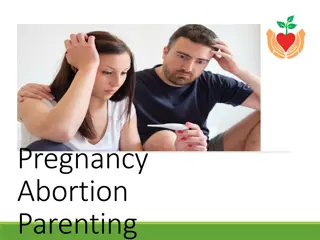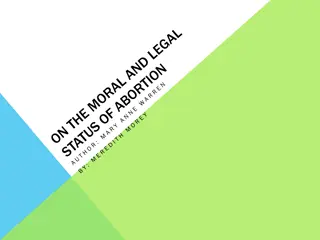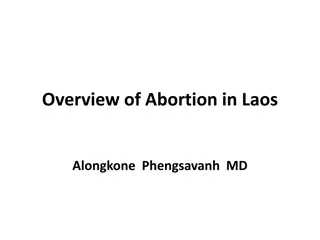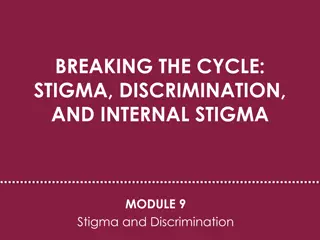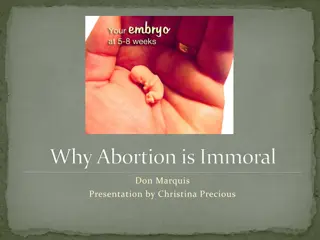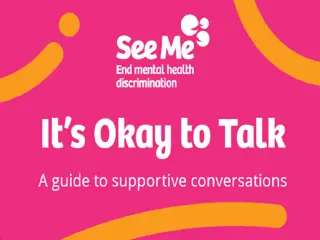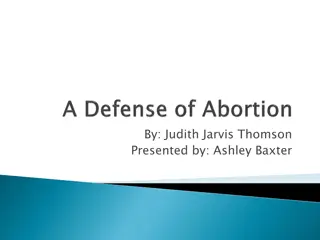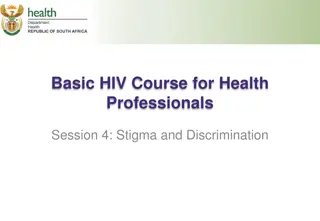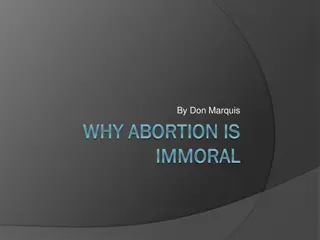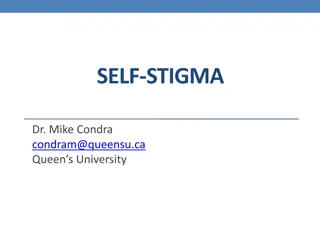Understanding Abortion Stigma - Insights and Implications
The content delves into the complexities of abortion stigma, exploring key definitions, effects of stigma on women's wellbeing, and reflections on its existence across time and location. It addresses why abortion is stigmatized, different levels of stigma, and the impact on individuals, communities, laws, and media portrayals. Through case vignettes and discussions, it aims to analyze and challenge societal perceptions surrounding abortion stigma.
Download Presentation

Please find below an Image/Link to download the presentation.
The content on the website is provided AS IS for your information and personal use only. It may not be sold, licensed, or shared on other websites without obtaining consent from the author. Download presentation by click this link. If you encounter any issues during the download, it is possible that the publisher has removed the file from their server.
E N D
Presentation Transcript
Understanding Abortion Stigma Understanding Abortion Stigma STIGMA 101
o Key definitions and ideas of stigma (lecture) o Effects of stigma on women s wellbeing (lecture) o Stigma and abortion providers (lecture) Agenda o Locating stigma in our physical space (group discussion) o Providers as stigmatizers (small group discussion) o Case vignettes (small group discussion)
Definitions of Stigma Definitions of Stigma o An attribute that is deeply discrediting o Whole and usual person becomes damaged, tainted, and discounted person o Erving Goffman, 1963 o Stigma is a social process and requires a stigmatizer o Stigmatized work = dirty work o Gravediggers, garbage collectors, abortion providers
Abortion stigma Abortion stigma Why is abortion stigmatized? Illegal/restricted in many parts of the world Seen as equivalent to killing Deviates from beliefs about traditional gender roles and idealized notions of femininity and womanhood A way to express disapproval of women s sexual behavior
Reflections on Stigma Has abortion-related stigma always existed? How does it differ across time and location? Does it differ in settings where abortion laws are liberal versus where abortion laws are more restrictive? How does stigma emerge across the various reasons women have abortion?
Levels of Abortion Stigma Levels of Abortion Stigma DISCOURSE & MEDIA I could see this bumper sticker and it just said abortion on the top. I was dying to see what it said underneath what it said was, abortion: one dead, one wounded . And I thought, why, why? That is so unfair. Why, why do I have to take this? INSTITUTIONAL/ ORGANIZATIONAL The E.R. docs will invariably say some crap about the jokers over at the abortion clinic There is this implied stereotype that doctors who do abortions are hacks [who] can t do any other part of medicine LAW AND POLICY We have to fear breaking the law when doing our job INDIVIDUAL It can be very hard to work at a clinic like this. There s a lot of guilt. A lot of paranoia and fear that you have to live with that you don t really think about. COMMUNITY if something bad goes wrong here and everybody in the world knows that I am an abortion doctor, will I be able to go to church?
The stigma The stigma- -silence vicious cycle silence vicious cycle Stigma Silence
Effects of Stigma on Women Effects of Stigma on Women Shame, guilt, disgrace Social isolation, loss of relationships Violence Criminal punishment Maternal mortality Figure 1. Ipas, 2014
Stigma and Abortion Complications Stigma and Abortion Complications Ethiopian health professionals estimate that 40% of women who have an abortion outside of a health facility experience serious complications and that 74% of these women receive treatment for their complications. Hard to know how many women die from unsafe abortion complications, but contributes to an estimated 17% of all maternal deaths in East Africa
Stigma Stigma- -Complications Vicious Cycle Complications Vicious Cycle Complications Stigma
1. Stigma hurts women 2. Leads to unsafe abortion even in settings in which legal and safe abortion is available Why consider Why consider stigma and stigma and complications complications together? together? 3. A matter of public health and maternal mortality 4. Can cause complications even when abortion is not provided
Kellys Story Kelly s Story Kelly was 18 years old when she was arrested and imprisoned in June 2013. She was 17 years old when she became pregnant. Under Rwandan law, anyone under 18 is considered a minor and presumed unable to consent to sex. She explains what happened: I was a student. A guy requested me to pay him a visit, and then he made me pregnant. I went back to school but he told me that he would look for someone to assist me to have an abortion. After two months, he brought me a tablet. After giving it to me, he disappeared. I swallowed the tablet and got a miscarriage. Kelly took the pills in the school bathroom. When she began suffering from complications, the school administration intervened and reported her to the police. Kelly had no legal representation during her trial and pleaded guilty in order to get a reduced sentence. Given that Kelly was 17 at the time she got pregnant, and this is considered rape under Rwandan law, she was legally exempted from prosecution. However, because she did not report the rape, she could not use this as defense for her actions. Kelly was sentenced to one year in prison (Kane, 2015).
Stigma and pathways to complications Stigma and pathways to complications Stigma impacts our ability to cope with and recover from complications Stigma can turn safe care into unsafe care Safe setting Abortion decision Complication Treatment Recovery Unsafe setting Stigma makes managing complications difficult Stigma causes women to seek unsafe care All of these sites involve relationships which are impacted by stigma
Safe setting Relationship dynamics Poverty Sex Abortion decision Complication Contraceptive use Unintended pregnancy Treatment Recovery Unsafe setting
Stigma and pathways to complications Stigma and pathways to complications Stigma impacts our ability to cope with and recover from complications Stigma can turn safe care into unsafe care Safe setting Abortion decision Complication Treatment Recovery Unsafe setting Stigma makes managing complications difficult Stigma causes women to seek unsafe care All of these sites involve relationships which are impacted by stigma
Effects of Stigma on Providers Effects of Stigma on Providers Positive Outcomes Negative Consequences Motivation, pride, and purpose for work Resiliency and strength Could strengthen abortion-providing workforce by focusing on positive aspects of stigma Shame, guilt, disgrace Social isolation, loss of relationships Additional consequences for providers: Threats of violence Harassment Criminal prosecution Extortion
Why stigmatize abortion providers? Why stigmatize abortion providers? o Deviates from lifesaving ideals of medical profession o Association with criminal activity
Stigmatized work = Dirty Work Physical taint Social taint Moral taint Dirty Work
Examples of labeling and stereotyping Examples of labeling and stereotyping A person who performs an abortion: Is a bad person Lacks morals Is a hack with poor skills Is committing a crime and/or a sin Is doing it just for money Doesn t care about women
Legitimacy Paradox Legitimacy Paradox Providers don t speak about abortion work Providers fear further devaluation/ violence if their abortion work is known Providers are depicted stereotypical incompetent butchers A social norm is perpetuated that abortion providers are incompetent or dangerous or deviant Doctors experience marginalization/ devaluation/ harassment
Stigma Mapping Stigma Mapping How do we experience these levels of abortion stigma here? Insert image of clinic/hospital floorplan or other relevant community space
Debrief Questions Debrief Questions How did you feel throughout this activity? Did anything in this discussion surprise you? How does it feel to discover ways in which stigma is evident in the practices and structures of our clinics and community? What are the ways that we can mediate the effects of stigma in these spaces?
Providers as Stigmatizers: Impact on patient care How does discomfort with and even judgment about the reasons some women have sex, experience unintended pregnancies, and seek abortions affect our work as providers? How might our discomfort and/or judgment impact quality of our care?
Providers as Stigmatizers Providers as Stigmatizers Think about examples of patients that make you angry (e.g. women who need second trimester abortions, women with little money to pay for their procedure, women who have multiple abortions). Do you see this particular example as problematic? Why or why not? How do these attitudes contribute to or perpetuate abortion stigma?
Case Vignettes: Complications Questions for case vignettes: What are your reactions to these cases? In what ways is abortion stigma apparent and influential in the reactions of all participants and outcomes of these cases? How would these cases been different had abortion stigma not been present? What/who needs to change to reduce abortion stigma in these cases? How does this influence your work as a provider?
Case Vignettes: Disclosure Questions for case vignettes: What are your reactions to these cases? Have you experienced any similar situations regarding disclosing your work? How would you have negotiated these decisions of disclosure? How does this influence your work as a provider?
